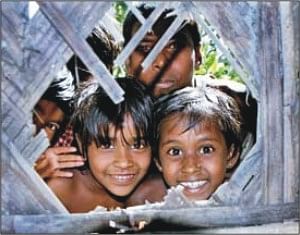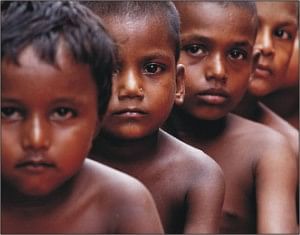Human Rights Monitor
Child trafficking: South Asia perspective
Every child is an individual by behavior in its own right. They are the precious possessions of this world. They deserve love, affection and care. Child Trafficking is the most inhumane violation of a child's rights. Children must be protect from all forms of risk and exploitation. The Bangla equivalent of the word trafficking is Pachar. It has a mild connotation, which means transfer from one place to another. If the term Pachar is used in reference to women and children, in Bangla the phrase Nari O Shishu Pachar means illegal transfer of women and children from one place to another. Trafficking, which is a serious problem and is considered a violation of human rights, is yet to be internalized emotionally by society at large in Bangladesh, and also in other South Asian countries.
 |
Photo: Save the children, Denmark |
Various definitions are used by international organizations to describe Trafficking. The definitions tend to focus on gender, age, reason for trafficking, and the issues of coercion and violence that are often association with trafficking. Although the sex work dimension is an important element, particularly through not exclusively in the traffic of females, trafficking activities are not only for purposes related to sex work or prostitution. Thus definitions tend to be general and encompass not only the sex and age of the trafficked persons but also the different purposes for which people are trafficked.
The countries of the South Asian Association for Regional Cooperation (SAARC) have a definition in their convention for Preventing and Combating Trafficking in Women and Children. Nevertheless, a consultation workshop organized by the resistance network in Bangladesh in August 1999 made suggestions for changes to the convention. From this workshop the following definition s were proposed:
“Trafficking in women consists of all acts involved in the procurement, transportation, forced movement, and/or selling and buying of women within and /or across border by fraudulent means, deception, coercion, direct and/or indirect threats, abuse of authority, for the purpose of placing a women against her will without her consent in exploitative and abusive situations such as forced prostitution, forced marriage, bonded and forced labour, begging, organ trade, etc.”
“Trafficking in Children consists of all acts involved in the procurement, transportation, forced movement, and/or selling and buying of children within and/or across border by fraudulent means, deception, coercion, direct and/or indirect threats, abuse of authority, for the purpose of placing a women against her will without her consent in exploitative and abusive situations such as commercial sexual abuse, forced marriage, bonded and forced labour, begging, camel jockeying and other sports, organ trade, etc.”
Trafficking Routes
Bangladesh has a 4,222-kilometer long border with India and a 288 kilometer common border with Myanmar. Nearly half (28) of the districts of Bangladesh have common borders with India and two have borders with Myanmar. Monitoring and policing any unlawful activities be it trafficking of humans or smuggling, is a gigantic task and traffickers take advantage of this situation. The most preferred route used by traffickers is the land route followed by air and waterways.
 |
Photo: Aparajeyo-Bangladesh |
There are as many as 18 transit points along the India-Bangladesh border through which children and women are smuggled out of the country. The border areas of Khulna, Jessore, Rajshahi, Dinajpur, Rangpur, Mymensingh, Comilla, Brahmanbaria, and Sylhet are frequently used as land routes for trafficking. In the northern region, the districts of Kurigram, Lalmonirhat, Nilphamari, Panchagarh, Thakurgaon, Dinajpur, Naogaon, Nawabganj and Rajshahi and in the South Jessore and Satkhira are the areas in which women and children are most susceptible to trafficking. Cox's Bazar is also a common site for the recruitment of children and women to be trafficked because there are three muslim rohinga refugee camps in this district from which traffickers obtain victims. Although reports and studies identified these border routes, traffickers use different routes at different times to avoid police and other law enforcement agencies. Herefore, for entering India through Kolkatta, the two most common routes are the Benapol borders in jessore from which almost 50% of the trafficking take place and Satkhira (Source: Trafficking of Women and Children In Bangladesh, 2001, ICDDR,B).
Most reports emphasis that, in recent years, there has been a significant increase in the number of children and women being trafficked into India and Other countries, from Bangladesh. The causes of trafficking and the factors leading to this apparent increases in recent years are multiple and complicated. These factors are embedded within the socioeconomic structure of the country and require an in-depth analysis. However, for the present purposed the factors have been categorized into two groups. The first group, the “push” factors are the conditions in the environment of the “sending” communities or countries that ensure a supply of people for trafficking. The second group refers to the set of “pull” factors that support the demand for trafficked persons.
Causes of Trafficking
* Break up of traditional joint family and the emerging unclear families.
* Pseudo marriage
* Dowry demand
* Unequal power relations and discrimination in the family by gender and age
* Negative attitude towards women and the girl child
* Socialization which devalues the girl child
* Social stigma against single, unwed, windowed women
* Misinterpretation of religion regarding women
* Religious fundamentalism
* Complications out of conditionality and fraudulent practices in marriages/after marriages
* Child marriage, polygamy, incompatible marriages
* Easy divorce
* Incest
* Physical as well as mental illness, contagious diseases turning women as outcastes.
* Frustration in love, failure in conjugal life
* Enticements for better life e.g., job, prospect of marriage
* Globalization and export oriented growth model, consumerism
* Increased dependency of the guardians on the income of their girl child
* Natural disasters making families homeless and disintegrated
* Acute poverty forcing parents to abandon their children
* Lack of shelter for women in distress
* Inadequate government policies in favour of women
* Inadequate rural development projects for women and unemployed
* Lack of social security and safety
* Inefficiency of the law enforcement agency
* Corruption amongst the members of the law enforcing agencies
* Women released from jail/hazat are given to the guardians/custodians without proper/legal verification
* The malpractice of providing affidavit for women entering into the profession of prostitution without verification of age
* Complications of restoring to law is both expensive and time consuming for women victims
* Non-registration of female domestic help
Source: CWCS & Bangladesh Shishu Adhikar Forum.